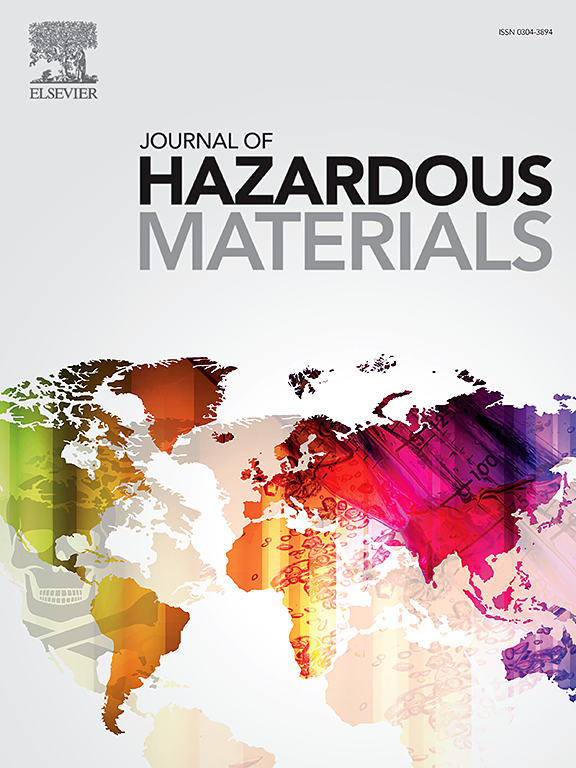Pressure Makes Diamonds: Enhanced Permeation Resistance to Petroleum Hydrocarbons of a Novel In-Situ Mixed Wall Material
IF 12.2
1区 环境科学与生态学
Q1 ENGINEERING, ENVIRONMENTAL
引用次数: 0
Abstract
Petroleum hydrocarbons pose severe environmental hazards, forming source zones in soil and groundwater with varying petroleum hydrocarbons-to-soil ratios (1.0-8.1%), necessitating innovative containment. To mitigate the flow of petroleum hydrocarbons-contaminated groundwater, an in-situ mixed amended sand-bentonite (SB) wall material, composed of contaminated sand with different diesel-to-soil ratios and styrene ethylene butylene styrene (SEBS)-amended bentonite, was proposed. Free swell test results revealed that the free swell index change (FSIC) of amended bentonite in diesel gradually increased until it stabilized after 14 days, with an accelerated increase on the 4th day. Hydraulic conductivity test findings indicated that the hydraulic conductivity of amended wall specimens permeated with diesel (kdiesel) exhibited a three-stage variation trend: gradual increase, gradual decrease, and stabilization. The peak kdiesel at the transition decreased with increasing diesel-to-sand ratio. The final kdiesel remained as low as 2.5×10-11-5.4×10-11 m/s. Microscopic analyses demonstrated that the pores of amended specimens after permeating with diesel were effectively plugged by SEBS gel. Mercury intrusion porosimetry analyses indicated reduced macropore volumetric percentages (41-53% versus 63-73% in unamended specimens). The SEBS’s kinetic swelling behavior is essential to the kdiesel of amended specimens, and this unique swelling could mask the diesel-induced compression on the diffuse double layer of bentonite particles.

压力造就钻石:一种新型原位混合壁材增强了对石油碳氢化合物的渗透性
石油烃对环境造成了严重的危害,在土壤和地下水中形成了不同的烃源区,其与土壤的比例(1.0-8.1%)不同,因此需要创新的遏制措施。为了缓解石油烃污染地下水的流动,提出了一种原位混合改性砂-膨润土(SB)墙体材料,该材料由不同柴油-土比的污染砂和苯乙烯-乙烯-丁烯-苯乙烯(SEBS)改性膨润土组成。自由膨胀试验结果表明,改性膨润土在柴油中的自由膨胀指数变化(FSIC)在14天后逐渐增大,趋于稳定,在第4天加速增大。水力导率试验结果表明,经修正后的壁样渗透柴油(kdiesel)后,其水力导率呈逐渐增大、逐渐减小和趋于稳定的三个阶段变化趋势。随着柴油砂比的增大,过渡阶段的峰值kdiesel降低。最后的kdiesel保持低至2.5×10-11-5.4×10-11 m/s。微观分析表明,柴油渗透后的改性试样的孔隙被SEBS凝胶有效地堵塞。汞侵入孔隙分析表明,大孔隙体积百分比降低(41-53%,而未修改的样品为63-73%)。SEBS的动力学膨胀行为对改性试样的kdiesel至关重要,这种独特的膨胀可以掩盖柴油引起的对弥散双层膨润土颗粒的压缩。
本文章由计算机程序翻译,如有差异,请以英文原文为准。
求助全文
约1分钟内获得全文
求助全文
来源期刊

Journal of Hazardous Materials
工程技术-工程:环境
CiteScore
25.40
自引率
5.90%
发文量
3059
审稿时长
58 days
期刊介绍:
The Journal of Hazardous Materials serves as a global platform for promoting cutting-edge research in the field of Environmental Science and Engineering. Our publication features a wide range of articles, including full-length research papers, review articles, and perspectives, with the aim of enhancing our understanding of the dangers and risks associated with various materials concerning public health and the environment. It is important to note that the term "environmental contaminants" refers specifically to substances that pose hazardous effects through contamination, while excluding those that do not have such impacts on the environment or human health. Moreover, we emphasize the distinction between wastes and hazardous materials in order to provide further clarity on the scope of the journal. We have a keen interest in exploring specific compounds and microbial agents that have adverse effects on the environment.
 求助内容:
求助内容: 应助结果提醒方式:
应助结果提醒方式:


